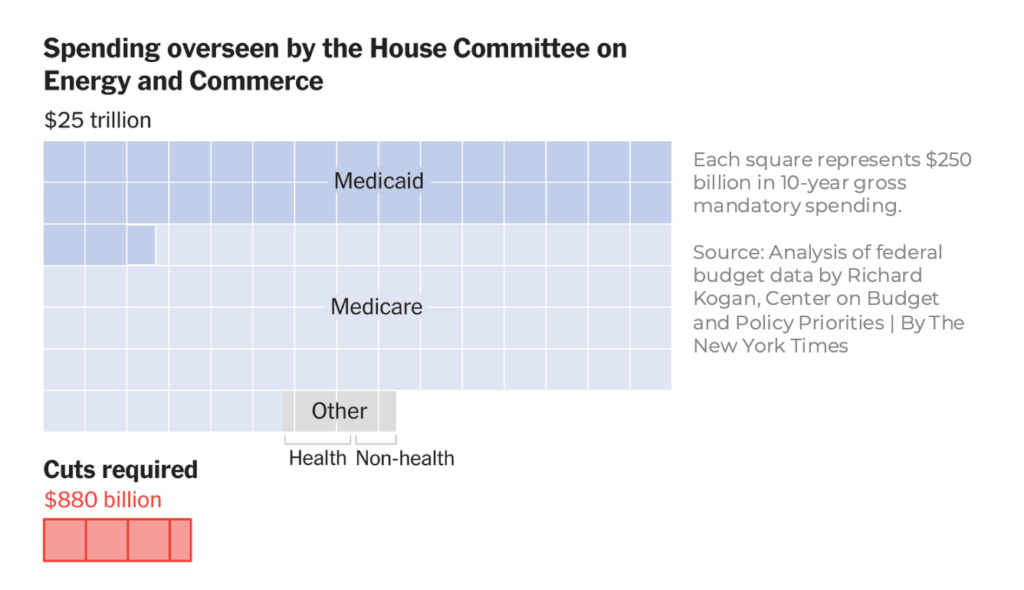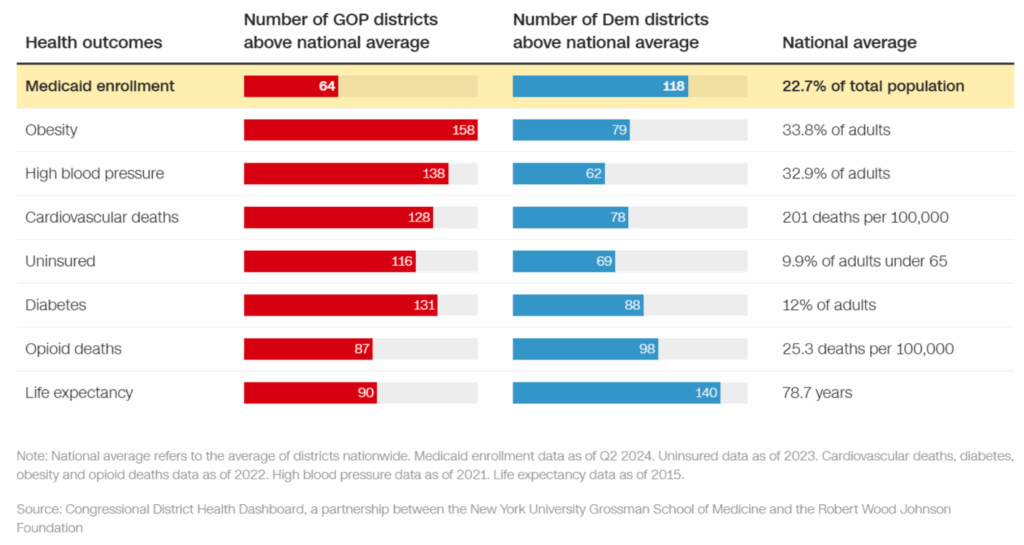Well, here we are, folks—another month, another set of regulatory updates. And let’s be honest: if you’d told me years ago that people would be eager to hear about federal budgets and Medicaid funding, I would have laughed. But here we are, and you’re here. That tells me how important this issue of Medicaid budget cuts is to all of us.
Let’s dive in.
Federal Workforce Cuts and Policy Shifts: What’s Changing?
In just the first two months of 2025, federal workforce reductions have sent shockwaves through agencies that fund critical health and human services.
And now, all eyes are on Medicaid.
With $880 billion in proposed Medicaid budget cuts, the program that provides healthcare to nearly 79 million Americans is at the center of a fierce budget battle—one that could reshape the future of healthcare access in this country.
Over 62,530 federal employees have been dismissed so far. Agencies that oversee Medicaid, housing assistance, and veteran services have been among the hardest hit. And this isn’t just a number—it’s a fundamental shift in how agencies operate, and it’s already impacting the programs we work with every day.
Key Cuts by Agency:
- HUD (Department of Housing and Urban Development): 780 employees cut, with evidence suggesting up to 4,000 additional layoffs could be coming.
- VA (Veterans Affairs): Over 1,300 VA employees terminated, with more expected (Newsweek).
- Social Security Administration: 7,000 job cuts planned (AP News).
- HHS (Health & Human Services): Employees offered buyouts—$25,000 to voluntarily leave their positions.
- SAMHSA (Substance Abuse and Mental Health Services Administration): Nearly half of its workforce eliminated.
That’s a lot of change in a short amount of time. And while the government is calling this an effort toward efficiency, for the industries we serve, it looks a lot more like instability.
These cuts raise serious questions about what comes next. When agencies overseeing Medicaid and public health initiatives are gutted, what happens to the services they support?
The Big Picture: Why Medicaid is in the Crosshairs
Medicaid has been a huge part of the federal budget debate, and for good reason—it’s a massive program, covering ~79 million people and costing the federal government $607 billion last year (KFF). But as budget negotiations intensify, that federal contribution is on the chopping block.
For the last few months, everyone has been asking the same question:
“Are they going to cut Medicaid? How much? Who’s going to be affected?”
And the reality is: yes, it’s in play.
The House Energy & Commerce Committee is backing $880 billion in Medicaid budget cuts—with 93% of those reductions specifically targeting Medicaid. That’s a big deal because Medicaid isn’t some small corner of government spending—it’s a core function of the healthcare system.
Republicans argue these reductions are necessary to finance tax cuts and increase defense spending, while Democrats and healthcare advocates warn that such cuts would destabilize state budgets and healthcare access (Axios).
On March 14, 2025, Congress passed a six-month government funding bill, avoiding a shutdown and extending federal funding through September 30, 2025 (PBS). However, this does not mean Medicaid is safe. The Medicare Rights Center warns that Medicaid budget cuts remain an active discussion, with potential consequences for states, providers, and beneficiaries.

But Medicaid is one of the biggest line items in the federal budget, making it a prime target for cost-cutting. However, cutting Medicaid funding doesn’t just shrink a number on a spreadsheet—it impacts real people, real providers, and entire state economies.
The question now isn’t if Medicaid will face cuts—it’s how deep and who will feel them first.
The Policy Proposals That Could Reshape Medicaid
Congressional leaders are considering multiple proposals to push forward Medicaid budget cuts. Each one carries profound consequences for states, providers, and beneficiaries. These would fundamentally reshape Medicaid funding as we know it.
The Big Five:
Cutting ACA Expansion Funding
- The Affordable Care Act’s Medicaid expansion currently covers low-income, non-disabled adults, with the federal government funding 90% of the costs.
- Some proposals suggest reducing this match rate, saving an estimated $1.9 trillion over 10 years (Urban Institute).
Implementing Per Capita Caps
- Instead of covering a percentage of actual costs, the federal government would set a fixed per-person limit, shifting financial risk to the states.
- Estimated savings: $900 billion over 10 years.
Lowering the Federal Medicaid Match (FMAP)
- Right now, the federal government must contribute at least 50% to state Medicaid programs.
- Proposals suggest reducing this floor to 45% (saving $350 billion) or removing the floor entirely (saving $600 billion) (KFF).
Introducing Block Grants
- Instead of open-ended matching funds, states would receive fixed lump sums—leaving them responsible for covering any shortfalls.
Imposing Work Requirements
- Would require Medicaid recipients to prove they are working to maintain coverage.
- Could jeopardize coverage for 37 million people (CBPP).

Discussions around work requirements for Medicaid recipients have also intensified. The NBC live coverage noted that key Republican leaders are pushing work requirements as a condition for Medicaid eligibility, a move that could affect millions of enrollees if enacted. (NBC News)
Each of these proposals represents a drastic shift in Medicaid funding—and none of these Medicaid budget cuts come without consequences.
What This Means for States and Providers
If these Medicaid budget cuts move forward, states will be forced to make hard decisions. They’ll have to:
- Raise taxes to make up the shortfall.
- Reduce eligibility, cutting people from the program.
- Slash provider payments, making it harder to keep services running.
Some states have trigger laws in place—meaning that if Medicaid budget cuts take effect, they are automatically required to scale back their programs.

Take New Jersey, for example:
- 700,000 people could lose coverage if cuts are enacted (NJ Spotlight News).
For providers, the ripple effects could include:
- Program closures due to uncertain funding
- Mergers & acquisitions (smaller agencies folding into larger ones)
- Delays in technology investments (including new EHR purchases)
Why Not to Panic (Yet)
After all that, let’s take a breath. Because here’s the thing: Medicaid is popular—across party lines (CNN).
- Families love it.
- Hospitals love it.
- States rely on it.


Budget proposals change fast. What’s on the table today for Medicaid budget cuts could be revised—or scrapped—tomorrow. So, while we need to stay alert, we also don’t need to panic just yet.
What Comes Next After the Missed Budget Deadline?
On March 14, 2025, President Trump signed a six-month government funding bill passed by Congress, preventing a shutdown. The bill extends funding through September 30, 2025, delaying major budget decisions but keeping Medicaid budget cuts on the table (PBS).
April 15 marked the deadline for Congress to finalize the 2026 budget resolution—but as of this writing, no clear outcome has emerged.
Even with the April 15th deadline, the six-month government funding extension through September 30, 2025, means that Medicaid funding battles are far from over.
With Congress missing the opportunity to finalize the budget yesterday, attention now shifts to the fall, when the temporary funding measure expires on September 30. That’s when the Medicaid budget fight is expected to intensify.
What can you do?
If you’re worried about how Medicaid budget cuts might affect your funding, reach out to us. Our experts are closely monitoring every development, and we’re happy to help you stay informed, educated, and empowered. If you’re unsure how to prepare, let’s talk.
Stay tuned for our next briefing this month. Until then—hold tight, keep an eye on the news, and don’t hesitate to reach out.
By Juliette Palmer, Regulatory Intelligence Analyst



